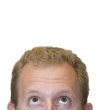Edit, Jan 2010: Don't do what I've outlined below without rigorous groundtruthing. Better yet, don't try this at all. The data returned by the camera sensor may be quite non-linear, and therefore not particularly useful. Try it yourself with a gel that has a serial dilution series covering a broad range of a protein quantities. Whereas x-ray film should return a fairly linear fit between protein quantity and density (darkness of the band on the film) as long as you don't over-expose, the camera may saturate in the blue channel over a broad range of protein quantities. In effect, you won't be able to tell apart bands that have lots of antibody but are slightly different. You will be able to tell the difference between high binding and zero binding, but the subtleties will be lost. Personally, I've gone back to x-ray film.
It turns out that you can detect western blot bands tagged with chemiluminescent reagents using a light-tight box and an SLR camera. The first picture below is a Canon 40D digital SLR fitted up against a gel imaging rig. Usually there would be a small digital camera sitting there, and the rig would provide ultraviolet trans-illumination to get enough light to see bands in an agarose gel. In this case I just laid my nitrocellulose membrane on the gel stage, closed the door, shut off all the lights in the box, and clicked off a 1:30 minute exposure on the Canon (f/2.8 ISO3200). The membrane was incubated in GE ECL Plus reagent, which proved bright enough to produce the blue bands in the second picture below. ECL Plus provides peak light output around 440 nm, which gives the bands their blue color.


This is certainly easier than exposing and developing x-ray film, and arguably cheaper than buying a high-zoot western blot digital imaging system from a manufacturer. This could be accomplished with any light-tight box; it certainly doesn't require the fancy gel imaging rig shown above. A shorter camera-to-membrane distance and a faster lens would allow for shorter exposure times (the lens on the camera here is a Sigma 50mm f/2.8 macro, but a cheapo Canon 50mm f/1.8 is even better).
I typically shoot gels at ISO1600, f/1.8, with exposure times of 30s to 4 or 5 minutes depending on the range of brightness among bands on the membrane.
It turns out that you can detect western blot bands tagged with chemiluminescent reagents using a light-tight box and an SLR camera. The first picture below is a Canon 40D digital SLR fitted up against a gel imaging rig. Usually there would be a small digital camera sitting there, and the rig would provide ultraviolet trans-illumination to get enough light to see bands in an agarose gel. In this case I just laid my nitrocellulose membrane on the gel stage, closed the door, shut off all the lights in the box, and clicked off a 1:30 minute exposure on the Canon (f/2.8 ISO3200). The membrane was incubated in GE ECL Plus reagent, which proved bright enough to produce the blue bands in the second picture below. ECL Plus provides peak light output around 440 nm, which gives the bands their blue color.


This is certainly easier than exposing and developing x-ray film, and arguably cheaper than buying a high-zoot western blot digital imaging system from a manufacturer. This could be accomplished with any light-tight box; it certainly doesn't require the fancy gel imaging rig shown above. A shorter camera-to-membrane distance and a faster lens would allow for shorter exposure times (the lens on the camera here is a Sigma 50mm f/2.8 macro, but a cheapo Canon 50mm f/1.8 is even better).
I typically shoot gels at ISO1600, f/1.8, with exposure times of 30s to 4 or 5 minutes depending on the range of brightness among bands on the membrane.

